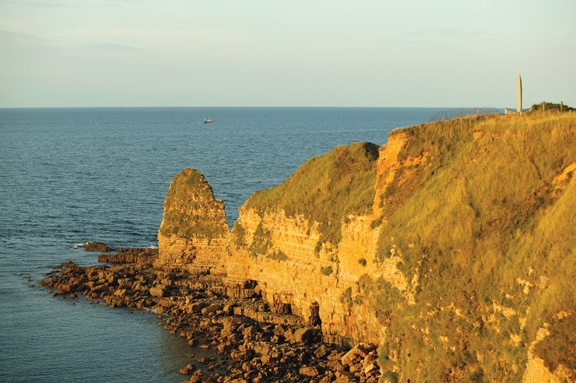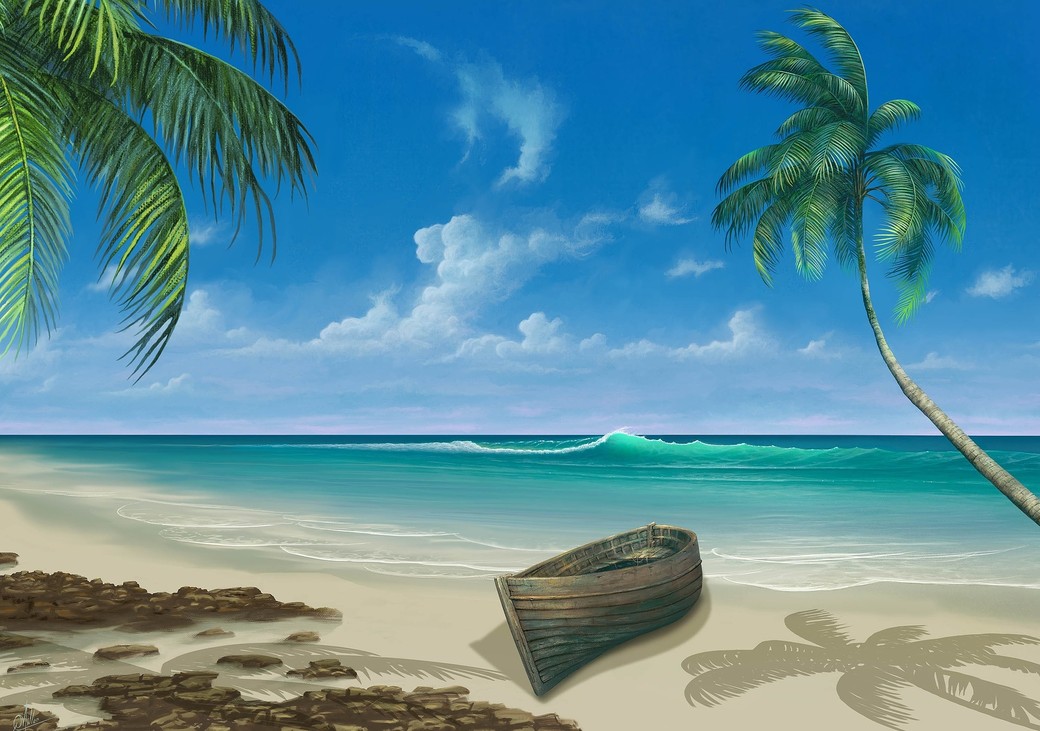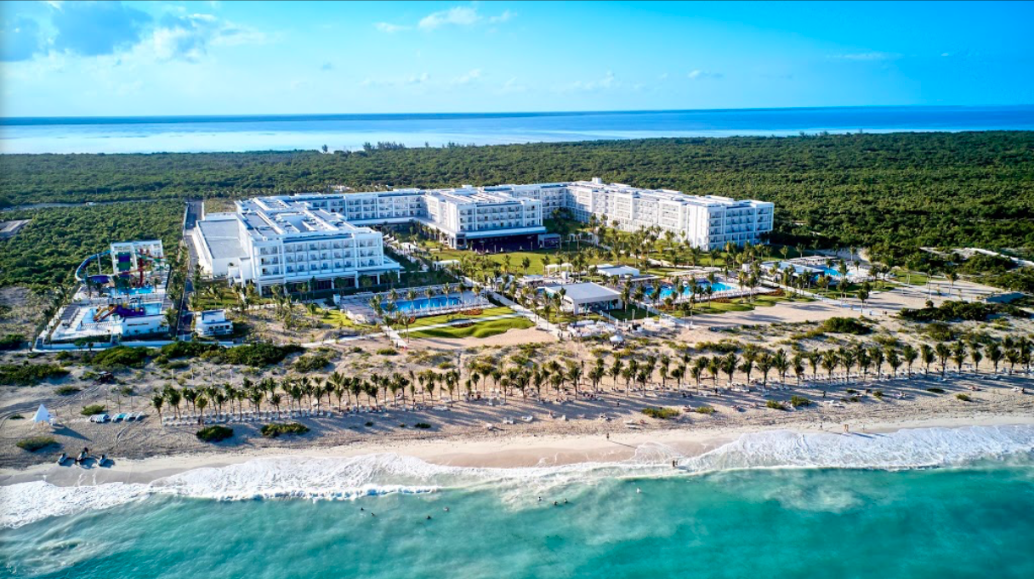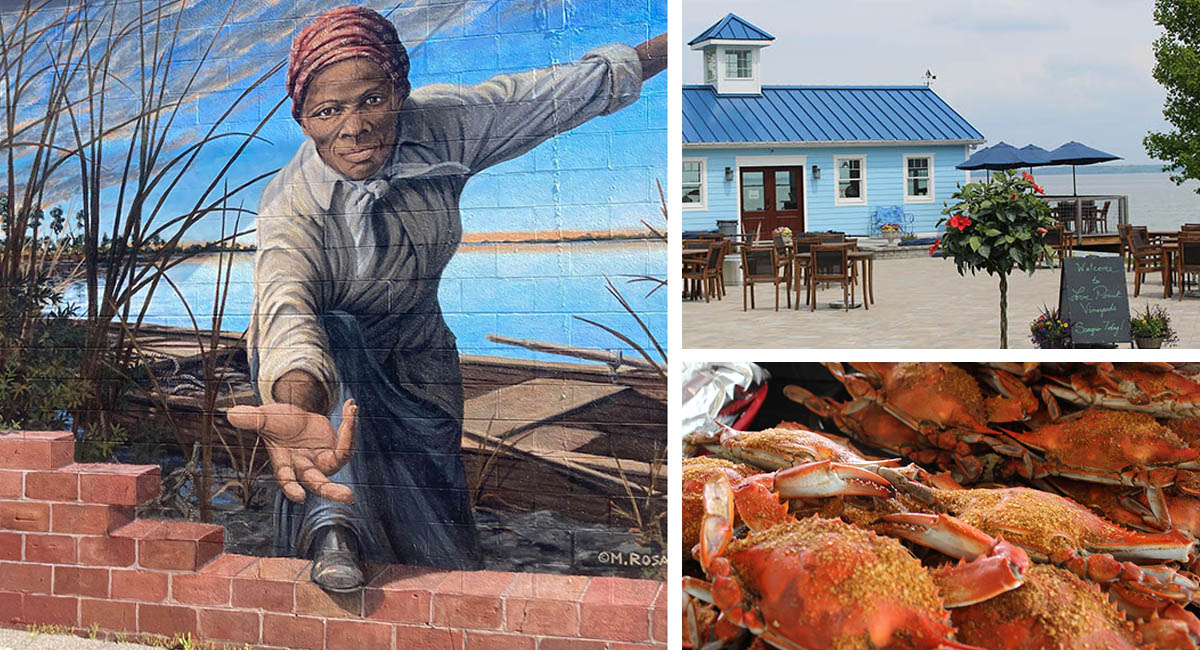
Vive la France!
The best surprise of the Normandy trip was the pleasant drive through the rolling hills and dotted farm houses that encapsulate the entire region. In six days of driving though Normandy we had only one day of overcast skies and rain. Otherwise, it was sunny with not a cloud in the sky. The lush green valleys and pleasant towns have a calming effect that is hard to describe. We stopped several times at cafés and the locals could not have been more pleasant or welcoming. I was excited about getting to the coast, I can sense it from miles away — it must be my Cape Breton roots. As soon as we did, I pulled over and took a big breath of the fresh sea air. It’s an exalting sensation – the closest thing I can compare it to is the “big sky” feeling you get when you visit Alberta for the first time. The natural high is immense.
Boulogne is a busy coastal town with people out on the beach, in the water and in the restaurants and pubs. Its cobbled streets and lively market is anchored in the city centre (Place Dalton) by the 13th century St Nicola Church, protector of Boulogne’s sailors.
Boulogne is on a downward slope to the sea. At the top of Rue de Lille is “old town”, the historic and religious centre. We took a guided tour through its narrow alleys and visited the 13th century Castle-Museum, the Belfry and Notre-Dame Basilica. We stayed at the Hôtel Les Terrasses de L’Enclos, a hundred-year-old building beautifully refurnished with modern amenities and with scenic views of the silhouette of old Boulogne. The hotel offers a pleasant French breakfast of home-baked bread, croissants, homemade jams and strong coffee. First up was a visit to the beach next to the Nausicaä (the National Sea Centre) were we tried land yachting. Imagine sitting on a go-cart with a sail that whips you down a sandy beach. We took a quick lesson and within minutes were pros. A key factor is wind. We had brief moments where we picked up speed followed by complete stops when the wind passed. It was fun and something I’d like to do again. The Nausicaä has to be one of the most impressive and relevant sea museums in the world. Our two-hour tour was like a journey through the world’s oceans and reminded us of our dependence on the sea. The museum curators have cleverly interspersed the history of the local seafaring people within a larger narrative about the fragility of the world’s oceans and the need for sustainable conservation of all ecosystems. Boulogne provided one of our great gastronomic experiences of the trip at the Brasserie de la Mer Boulogne-sur-Mer. A stylish and friendly place with seafood dishes to die for including the mixed grill of fish, cod, salmon, julienne St. Jacques, prawns and bacon, herring and potato terrine, scallops (a portion is five) and the fish of the day (a whitefish type of haddock). My son tried the crème brûlée and announced it was as good as mom’s which is very high praise indeed. It was delicious. Now it was off to Dieppe and the Normandy D-Day Beaches.
A dramatic chapter of Normandy’s history is its role as the epicentre of the World War II D-Day landings. This epic tale is one of tragedy and victory. The most appropriate place to start our D-Day tour of the region was in Dieppe.

For most Canadians the word Dieppe evokes a strong response. Five thousand troops of the 2nd Canadian Infantry Division landed at the French port of Dieppe on the English Channel Coast in August 1942. The purpose was to make a successful raid on German-occupied Europe over water, and then to hold Dieppe briefly. The results were disastrous. In a nine-hour raid involving nearly 5,000 Canadian soldiers, more than 900 were killed and 1,874 taken prisoner — more prisoners than the army lost in the 11 months of the 1944-45 NW Europe campaign.
As we drove into Dieppe we were struck by the quaint beauty of this seaside gem. Cafés along the waterfront were bristling with activity and the stores in the market square were just closing down for the day. The coastal road in front of the town abruptly ends and then veers in a u-turn back toward the centre. There is a rock face right at that turn and painted on that rock face is a huge Canadian flag that says “thank you, Canada”. It was an unexpected sight but speaks volumes about the feeling of the people of Dieppe towards Canada. I immediately felt comfortable and at home – almost like Dieppe was somehow a part of Canada. We visited the only Dieppe Museum that pays tribute to our soldiers’ sacrifices. It is a small museum next to the beach run by local French veterans. It has artefacts and uniforms and an impressive collection from many of the Canadian soldiers who fought in the battle. Despite numerous attempts by these French vets to engage the Canadian government and officials from Canada’s War Museum, no Canadian government officials had ever visited this place. The French veterans opened the museum to keep the memory of the Dieppe Raid alive. (OLM has since met the officials at the Canadian War Museum to advise them of the collection and French Veterans’ requests but 10 months later they have yet to engage these French veterans to try and secure this important collection which is a critical piece of our national history).
We stayed at the Au Grand-Duquesne Hotel in the city centre next to the market. This boutique hotel is a unique and stylish place, just a stone’s throw from the Dieppe harbour. The best reason to stay here is its gourmet restaurant and exceptional wine cellar. Any trip to Normandy cannot pass without experiencing a classic Normandy recipe perfectly executed. We tried the escargots and a lamb dish, with an elegant Côtes du Rhône. The Friday night atmosphere (it’s a favourite haunt of the locals) and service were a perfect way to celebrate Dieppe and toast our Canadian vets.
The next morning we departed for the Château de Taillis August 1944 Museum in Duclaire, a pretty town near Rouen. We strolled around for over an hour absorbing ourselves in their authentic collection of D-Day artefacts from Allied and German soldiers. The goal of the museum is to be an educational resource for area students who have never been touched by war.
Afterwards we were off to Normandy’s historic capital city – Rouen. Described by Victor Hugo as “The city of 100 steeples”, Rouen is also known as the place where Joan of Arc was convicted and burned at the stake in 1431 at the Place du Vieux Marché or as the city that was the inspiration for Monet’s Cathedral Series. Rouen was heavily damaged and lay in ruins at the end of World War II after a particularly brutal occupation by the Nazis. Liberated by the Canadian First Army on August 30, 1944, the residents used ingenuity and determination to rebuild Rouen to its former glory. Today, it is a spectacular city of young families and busy professionals. We walked along the Seine and stopped for a wonderful lunch at the Brasserie Paul next to the Cathedral. Then we were off to see the Gros Horloge, a beautiful golden clock in the centre of Rouen. You can climb the belfry (steep spiral staircase) to see how the clock mechanism works and view the town bells. At the top of the belfry is a magnificent view of the city of Rouen with its charming half-timbered houses, historic Place du Vieux Marché (Old Market Place), home to the modern Church of Jeanne d’Arc and the daily market which is the heart of Rouen. The Place also features numerous restaurants including Les-Maraichers, a favourite of the locals.
The Inter-hôtel Notre Dame is a safe bet in Rouen. It is centrally located, clean, comfortable, and quiet and offers easy access parking and a nice breakfast! The next morning we departed for Honfleur, the picturesque and colorful harbor city located on an estuary of the Seine River. Honfleur’s timber-framed houses and the narrow backstreets inspired the painters Claude Monet, Eugène Boudin, Johan Jongkind, and Gustave Courbet and it is regarded as the birthplace of Impressionism. Saint Catherine Church, built in the 16th century in the port of Honfleur, is the largest wooden church in France and offers mass and religious services daily. The “Vieux Bassin” in Honfleur is packed with tourists and sightseers. For Canadians, Honfleur is historic. In 1506, Jean Denis departed Honfleur for Newfoundland and the mouth of the Saint Lawrence. In 1608, Samuel de Champlain departed from Honfleur and arrived in Quebec, becoming the “The Father of New France” and founder of Canada. It was a wonderful moment to be in the town where it all began. We felt a kinship with the place that maybe only Canadians can feel. The irony was not lost on us that it would be Canadians, the proud descendents of Champlain, who would come back to the Honfleur region hundreds of years later to free the French from their Nazi captors.
Our final Normandy trek was to the D-Day beaches. During the nights of June 5 and 6, 1944, more than 16,000 paratroopers landed in Normandy. British, American and Canadian troops landed on various beaches on the Normandy coast and engaged in heavy fighting which eventually led to the end of the European theatre of WWII. A key objective in the days after the invasion was to take the city of Caen from the Germans. We decided to go to the Caen Memorial first before heading to the beaches. Established in 1988 and dedicated to peace, the Caen Memorial (Le Mémorial de Caen) is regarded as the best World War II museum in France.
Over the next two days we stopped at all the D-Day landing beaches, including Utah Beach, Omaha Beach, Sword Beach, Juno and Gold beaches. Highlights included visiting the Canadian military cemetery of Bény-sur-Mer and the American cemetery in Colleville-sur-Mer where many of the soldiers featured in the famous series Band of Brothers are laid to rest. We spent half a day at the The Juno Beach Centre at Courseulles-sur-Mer, which opened on June 6, 2003. The Centre presents the war effort made by all Canadians, civilian and military alike, both at home and on the various fronts during the Second World War. The Minister of Canadian Heritage has designated the Juno Beach landing site to be a site of national historic significance to Canada.
After the beach visits, we went to Bayeux and checked in at the Hôtel le Brunville. Located in the heart of Bayeux, this hotel proved to be a great staging point for day trips in the area.
The beaches of Bessin near Bayeux are still known for the Allied landings in June 1944. Historically the beaches of Bessin have always been popular seaside resorts. Back in 1858, with the opening of the Paris-Caen-Cherbourg railway, people started to flock to the beaches at Asnelles, Arromanches, Courseulles-sur-Mer, Vierville-sur-Mer and Grandcamp-Maisy. The joy of seaside recreation attracted wealthy Parisian families which led to the development of the Hôtel Belle-Plage, Grand Hôtel des Bains in Asnelles, Hôtel des Touristes in Vierville and many opulent villas like the Villa Les Tourelles in Arromanches and the Villa les Hirondelles in Grandcamp-Maisy by the sea. My favourite place for the entire trip was the beach town of Ouistreham. We stayed at the hotel La Mare Ô Poissons and had a gourmet dinner in their restaurant. We walked through the picturesque town and strolled along its beaches. Today these spots are as popular as ever for the French and for foreign tourists alike who enjoy a tranquil respite of sandy beaches, mild temperatures, natural beauty and the exceptional and welcoming hospitality provided by the locals. France’s Normandy region is thriving; the soldiers who liberated it would be pleased to see that all is back as it should be.










